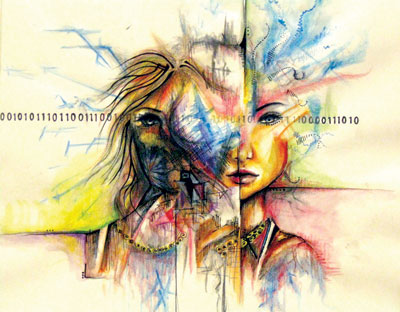All Nonfiction
- Bullying
- Books
- Academic
- Author Interviews
- Celebrity interviews
- College Articles
- College Essays
- Educator of the Year
- Heroes
- Interviews
- Memoir
- Personal Experience
- Sports
- Travel & Culture
All Opinions
- Bullying
- Current Events / Politics
- Discrimination
- Drugs / Alcohol / Smoking
- Entertainment / Celebrities
- Environment
- Love / Relationships
- Movies / Music / TV
- Pop Culture / Trends
- School / College
- Social Issues / Civics
- Spirituality / Religion
- Sports / Hobbies
All Hot Topics
- Bullying
- Community Service
- Environment
- Health
- Letters to the Editor
- Pride & Prejudice
- What Matters
- Back
Summer Guide
- Program Links
- Program Reviews
- Back
College Guide
- College Links
- College Reviews
- College Essays
- College Articles
- Back
Why "Brain on Fire" Should Enter the Curriculum
For twenty-four year old Susannah Cahalan, a once structured and successful lifestyle can easily transform into a rapid descent into madness. In her novel, Brain On Fire, Cahalan highlights a period of her life in which she experienced traumatic and unbelievable symptoms of an undiagnosed disease that could have ultimately lead to her early demise. Through its relevance to common core, relation to common teenage emotions, and teaching opportunity as a nonfiction novel, Brain on Fire would make an excellent addition to the high school Sophomore English curriculum.
Students in the United States are held to a set of educational standards known widely as common core. Through these standards, students are expected to acquire a variety of skills such as ability to determine theme, recognize character development, and understand authors choice of structure, all in attempt to increase their reading proficiency and comprehension. Brain on Fire, as a novel classified in the adult genre, is able to push its young readers to a difficult, but achievable level of comprehension through its presentation of these aspects. Susannah Cahalan, as the main character of the novel, can actively be seen undergoing various changes in character throughout her story. Cahalan’s stable state of mind in the beginning of the novel transcends into that as if of another person, starting with
episodes of “paranoid aggression”, “childlike” state of mind, then transforming into something far more serious (Cahalan 58). As noted by Cahalan, people with whom she shares her condition often feel “far away from the person they were before the illness” (Cahalan 216). This aspect of character development falls directly into the expectations of common core.
Throughout Brain on Fire, there are consistent tones of apprehension, uncertainty, and support. Although they may have little or no experience with diseases such as that which afflicted Cahalan, youth can most definitely relate to these emotions and their impacts on one’s life. After Cahalan received an early diagnosis from her physician, Dr. Najjar, the two had a crucial moment in which Cahalan realized “I was there, and he would not give up on me.” (Cahalan 134). This touching moment has strong relation to the lives of modern teenagers who often find themselves in need of support for issues they face in their lives. Later in the novel when Cahalan received an official diagnosis, she became the “217th person to be diagnosed worldwide since 2007” (Cahalan 151). With such a small number of patients diagnosed with her disease and therefore little experience with its effects, there was a tremendous amount of apprehension towards the fate of Cahalan’s life. Many teenagers can relate to this feeling of uncertainty. With the pressures of growing up and pursuing a higher education, it is common for today’s youth to feel apprehension towards their own lives, similar to the feelings of Cahalan.
As a detailed recount of true events, Brain on Fire provides the perfect opportunity to teach the nonfiction genre as well as encourage communication skills between students. It is stated throughout the novel that many elements were based upon the observations of those involved as well as documents of the events that took place throughout. In one particular video, Cahalan observed herself screaming “‘Please, please, please. Oh my god, oh my god. Please get me a doctor. Please get me a doctor. Please, please, please.’” (Cahalan 88). From the frightful state of mind she observed herself in, Cahalan was able to piece together parts of the story that she was unable to recall from memory. This aspect however, creates a feeling of suspicion throughout the novel towards its truthfulness. It would be beneficial for students to develop a better understanding of this concept through in-class education so that they can better appreciate the story. Not only this, but the possibility of a more truthful reality opens discussion for students, furthering their communication abilities by allowing them to share their opinions with one another.
With such a vast selection of novels and strict code of elements to abide by, there is a fair amount of books that fit the standards of that which belongs in a high school Sophomore English class. Brain on Fire, standing as a representation of the ability of life to change in an instant, provides key elements that make it suited for the classroom. Through its presentation of common core elements, relatable emotional themes, and nonfiction aspects, Cahalan’s novel proves itself to be an excellent fit for the curriculum.

Similar Articles
JOIN THE DISCUSSION
This article has 0 comments.
